Today’s recipe is bibimbap, a super-popular Korean dish you might have heard about already! It’s made of a bowl of rice, sautéed and seasoned vegetables (namul: 나물), a bit of hot pepper paste (gochujang: 고추장), and usually a bit of seasoned raw beef, too (yukhoe: 육회).
Bibim (비빔) translates as “mixed,” and bap (밥) means “cooked rice,” so bibimbap literally means “mixed rice.” Before eating it you’re supposed to mix everything all together.
There are many variations on this dish, from simple to elaborate, and this recipe I’m showing you today is for one you could consider “classic” bibimbap. If you ordered bibimbap in a Korean restaurant, you would probably get something like this dish, with regional variations. I’m also going to show you bibimbap prepared and served in a heated stone or earthenware bowl called dolsot-bibimbap (돌솥비빔밥). “Dolsot” means “stone pot” in Korean, and this version is well-known for the way the bowl makes a layer of crispy, crackling rice on the bottom of the bibimbap.
Even though we mix up bibimbap before we eat it, each ingredient needs to be prepared with care and individuality, bringing out their unique flavors, textures and colors so they come together beautifully in the bowl and deliciously in your mouth. The different ingredients aren’t random, they’re chosen because they balance, harmonize, and offset each other.
This recipe isn’t quick and easy, it takes some time to make. But if you’re really in a rush you can make a great bibimbap with the soybean sprouts, spinach, and carrot (or red bell pepper, or both), and gochujang, toasted sesame oil, and an egg— those items are unskippable!
I’m going to share some more bibimbap recipes on my website in the future, and you’ll see how many different variations there are. This version is a little different than the version in my cookbook, because I make a quick and simple soup with the bean sprouts. When I started my YouTube channel, bibimbap was one of the first recipes I made, because it’s such an essential dish in Korean cuisine. So I’m happy to remake the video now in HD with much better editing and instruction. I’ve been building up to this video by remaking videos for the ingredients, too. I remade yukhoe, and sigeumchi-namul, and my yukagaejang video has a lot of detail about preparing the mountain vegetable fernbrake.
So if you’ve been following my videos, you’re now ready to be a bibimbap master! Ready? Let’s start!
Ingredients
Serves 4
- 5 cups cooked short-grain rice
- 12 ounces soy bean sprouts, washed and drained
- 8 ounces of spinach blanched and washed with the excess water squeezed out by hand
- 1 large carrot
- 1 large red bell pepper
- 1 large zucchini
- 1 English cucumber
- 3 to 4 green onions, chopped
- ½ pound fresh lean cut of beef (fillet mignon, flank steak)
- 4 ounces fernbrake (gosari), fresh or soaked from ½ ounce dried gosari (details below)
- 1 ounce dried bellflower roots (doraji), soaked in cold water for 18 to 24 hours.
- 4 eggs
- kosher salt
- vegetable oil
- toasted sesame oil
- toasted sesame seeds
- garlic
- soy sauce
- honey (or sugar)
- Korean hot pepper paste (gochujang)
How to prepare dried fernbrake (gosari) for use
If you have presoaked or fresh fernbrake you can use it straight away, but if you have dried fernbrake you’ll need to get it ready to eat. It’s fast if you have a pressure cooker, but if you don’t it will take some time.
With a pressure cooker:
- Wash ½ ounce of dried gosari and boil it with 5 cups of water in a pressure cooker for 30 minutes.
- Drain and rinse in cold water a couple of times.
- Drain. It should make 4 ounces.
In a pot on the stove:
- In a large saucepan add ½ ounce of dried gosari to 7 cups of water. Bring to a boil over medium-high heat and boil for 30 minutes. Cover and let stand until cool, about 2 to 3 hours.
- Rinse the fernbrake a couple of times, drain and put in a bowl. Cover with fresh cold water and let soak for at least 8 hours or overnight in a cool place, changing the water 2 or 3 times during the soaking.
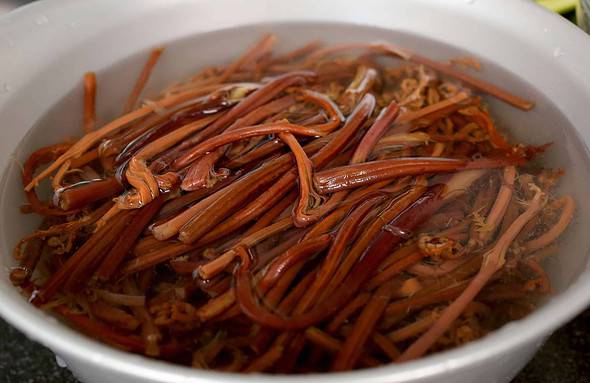
- Taste the gosari: It should be soft. If it’s tough, boil it again in a fresh pot of water for about 20 minutes and then let it sit, covered, until soft.
- Drain. It should make 4 ounces.
Make rice
If you have a usual method for making rice or have a rice cooker, go ahead and make 5 cups of rice like you usually do. But here’s how I do it on a pot on the stove. 2 cups of dried rice makes about 5 cups of cooked rice.
- Rinse 2 cups of rice in cold water and scrub the wet rice with your hand. Rinse and drain until the drained water is pretty clear.
- Put the rice in a heavy-bottomed pot. Add 2 cups of water, cover, and soak for 30 minutes.
- Cook over medium high heat for 7 to 8 minutes until the surface is covered with abundant bubbles that are spluttering noisily and look like they’re about to overflow the pot. Turn the rice over a few times with a spoon and cover the pot again.
- Turn the heat to very low and simmer for another 10 minutes until the rice is fully cooked and fluffy. Remove from the heat.
- Fluff the rice with a spoon to release excess steam. Let the rice stand, covered, at room temperature to keep it warm.
Prepare and cook the ingredients for bibimbap
I like to get a big platter and then put each vegetable on it as they’re ready. I think it looks really pretty, but you don’t have to do this. When all vegetables are prepared and ready to use, the platter looks pretty delicious!
Soybean sprouts:
- Put the soy bean sprouts in a pot and add 4 cups water and 2 or 3 teaspoons salt. Cover and cook for 20 minutes over medium high heat. Take out the sprouts with tongs and put them into a bowl, leaving about ½ cup of sprouts in the pot with the water you used to boil them. This is the soup to serve with bibimbap later.

- In a bowl, mix the sprouts by hand with ½ teaspoons salt, 1 teaspoon minced garlic, and 2 teaspoons toasted sesame oil. Put them on the large platter.
Spinach:
- Cut up the blanched spinach a few times and put it in a bowl. Mix by hand with 1 teaspoon garlic, 1 teaspoon toasted sesame oil, ½ teaspoon kosher salt, and 1 teaspoon sesame seeds. Cover and put it next to the soy bean sprouts on the platter.
Other fresh vegetables:
- Cut the carrot into matchsticks, put them in a bowl, and mix with a pinch of salt. Let stand for 5 to 10 minutes until sweating.

- Cut the red bell pepper into halves, deseed, and slice into strips. Put them in a bowl.
- Cut the zucchini into matchsticks and mix with ½ teaspoon kosher salt.
- Cut the cucumber into halves lengthwise and slice thinly crosswise. Mix with ¼ teaspoon kosher salt.
Beef:
- Cut the beef into matchsticks and put them in a bowl.
- Mix with 1 tablespoon minced garlic, 1 tablespoon soy sauce, 1 tablespoon honey, 2 teaspoons toasted sesame oil, and 1 teaspoon sesame seeds with a spoon.

- Cover and keep in the fridge until ready to use.
Mountain vegetables:
- Cut the fernbrake (gosari) a few times into bite size pieces. Set aside.
- Put the bellflower roots (doraji) in a large bowl. Add 1 or 2 tablespoons salt. Rub for a minute to wilt slightly and release some of the bitterness. Rinse them in cold water a couple of times and drain. If you find some roots are too thick, split them lengthwise. Set aside.
Let’s cook!
- Heat up a pan over medium high heat. Squeeze out excess water from the carrot. Add a few drops of cooking oil to the pan and sauté the carrot for 1 minute. Put it on the platter next to the soy bean sprouts and spinach. Clean the pan with wet paper towel or wash it.
- Heat a few drops of cooking oil in the pan and squeeze out the excess water from the cucumber. Sauté with ½ teaspoon minced garlic and a few drops of toasted sesame oil for 30 seconds. Put it on the platter. Clean the pan.
- Heat up the pan with a few drops of cooking oil. Add the red bell pepper and sprinkle a pinch of salt over top. Sauté for 30 seconds. Put it on the platter. Clean the pan.
- Heat up the pan and squeeze out excess water from the zucchini. Add a few drops of cooking oil and sauté with 1 teaspoon minced garlic, 1 tablespoon chopped green onion, a drop of toasted sesame oil for 1 minute until slightly softened. Put it on the platter. Clean the pan.
- Heat up the pan with a few drops of cooking oil. Add the bellflower roots and sauté for 2 to 3 minutes. Lower the heat to medium so as not to brown them. Add 1 teaspoon minced garlic and a drop of toasted sesame oil. Stir for another minute until a little softened. Put it on the platter. Clean the pan.

- Heat up the pan. Add a few drops of cooking oil. Stir the gosari for 2 minutes until a little softened. Add ½ teaspoon of minced garlic, 2 teaspoons soy sauce, and 2 teaspoons sugar, and keep stirring for another minute. Put it on the platter.
Serve
Here are a couple of ways to serve: bibimbap in a regular, shallow bowl, and dolsot-bibimbap in a stone or earthenware bowl.
In a regular, shallow bowl
- Reheat the soybean sprout soup.

- Divide the cooked rice into 4 portions. Each portion will be a little more than 1 cup of rice.
- Put the rice in each of 4 bowls and arrange the vegetables and beef on the rice. Top with a raw egg yolk and gochujang. If you prefer your eggs and beef cooked, use a fried egg sunny side up and slightly pan-fry the beef before putting them on the top of rice.
- Sprinkle the bibimbap with the sesame seeds and drizzle with sesame oil to taste.
- Ladle the soup to a small bowl and sprinkle some chopped green onion over top.
- Serve right away with more hot pepper paste on the side, and maybe kimchi too.

Dolsot-bibimbap in a hot earthenware bowl (ttukbaegi) or hot stone bowl (dolsot)
- Reheat the soybean sprout soup.
- Put a few drops of toasted sesame oil in the bottom of each of 4 earthenware bowls. They should be big enough to hold 4 to 6 cups each.
- Divide the rice among the bowls. Arrange the vegetables and beef on the rice. Top each serving with a raw egg yolk and 1 tablespoon gochujang. If you prefer your eggs and beef cooked, use a fried egg sunny side up and slightly pan-fry the beef before putting them on the top of rice.
- Set each pot on a burner. Heat over medium high heat until you hear a ticking, crackling sound coming from the rice.

- Sprinkle the bibimbap with the sesame seeds, drizzle with sesame oil to taste.
- Ladle the soup to a small bowl and sprinkle some chopped green onion over top.
- Serve right away with more hot pepper paste on the side and maybe kimchi too.

Eat
Maangchi's Amazon picks for this recipe
It's always best to buy Korean items at your local Korean grocery store, but I know that's not always possible so I chose these products on Amazon that are good quality. See more about how these items were chosen.



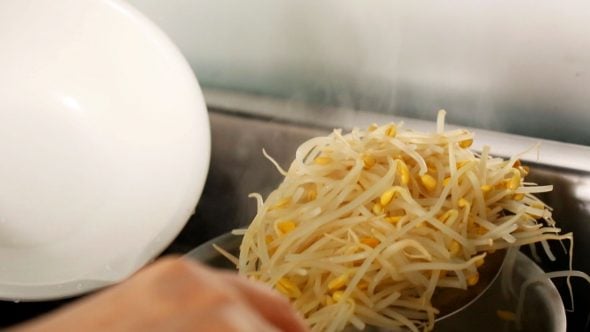
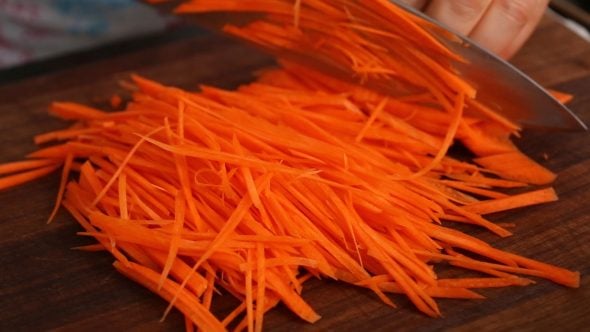
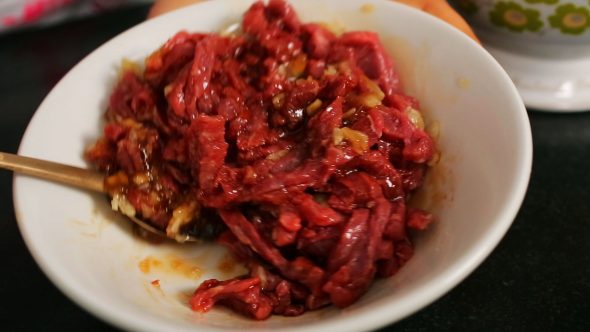
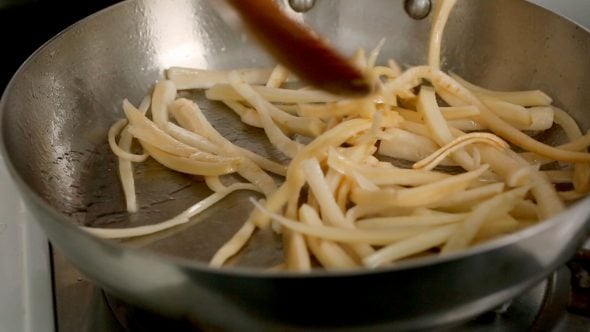
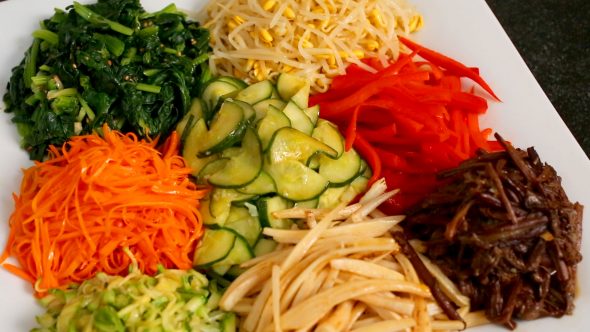
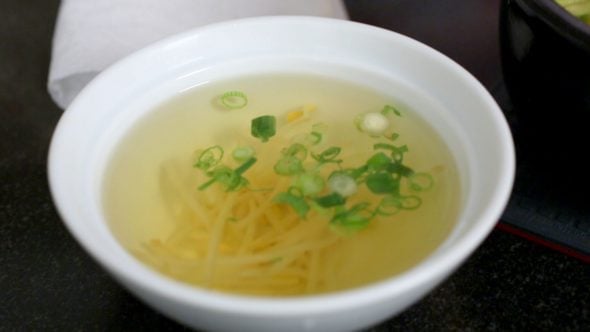
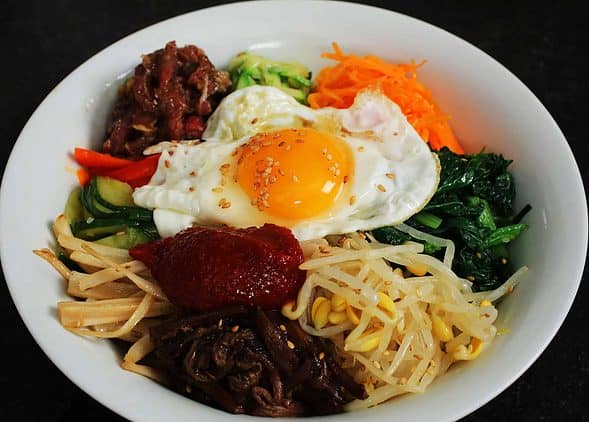

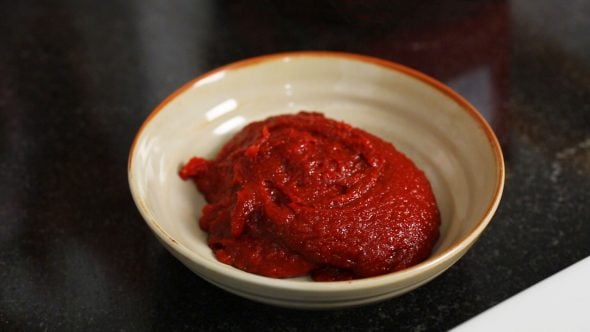
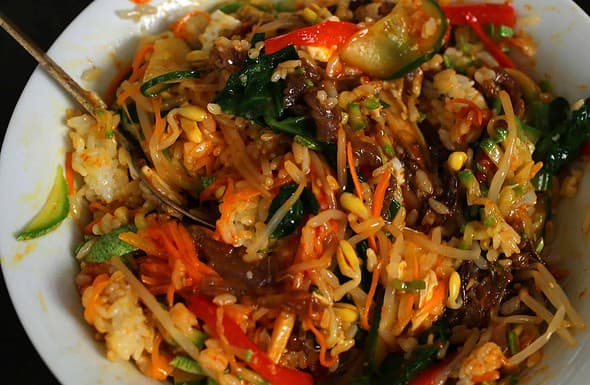






![[OTTOGI] Delicious COOKED RICE...](https://m.media-amazon.com/images/I/41zYdZ3EWJL._SL160_.jpg)




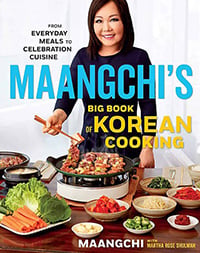





















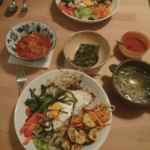

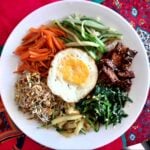
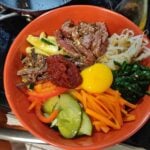
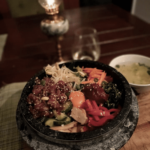
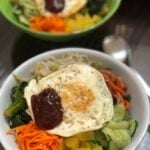



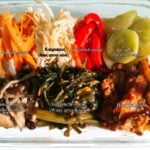
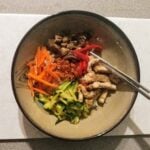
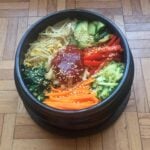

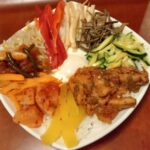

I love to watch korean movies and I from there I felt in love with the
different types of korean dishes. I was wondering if i could at least have the recipe for porridge that have in the movies.
oh, I posted abalone porridge recipe. https://www.maangchi.com/recipe/jeonbokjuk
You can replace abalone with shrimp, clams, or mussels.
Maangchi,
First off, I want to say that I LOVE your website!!
How long do you boil the kosari?
This is how to handle dried kosari (fernbrake) before cooking
Place kosari in cold water in a pot. 1 cup of kosari will need
more than 20 cups of water.
Boil it for 30 minutes and don’t drain hot water and let it soak. Wait about 6-8 hours.
I usually boil it at night and drain it next morning.
That’s it!
And pssttt, this is so much healthier than nasi goreng. ;)
Maangchi, thank you for posting everything up! My sister is in her early stages of pregnancy and her appetite isnt that good with the same old local food so I’ve been wanting to make her food from another culture for a chance. I will be sure to try this out. :) do you have any recipes that you would recommend for pregnant ladies??
Is your sister struggling with morning sickness or she is losing just appetite?
I can suggest these dishes for her: samgyetang, miyukguk, gamjajorim, samgak kimbap, and myulchi bokkeum.
samgyetang:
https://www.maangchi.com/recipe/samgyetang
miyukguk:
https://www.maangchi.com/recipe/miyuk-guk
gamjajorim:
https://www.maangchi.com/recipe/potato-side-dishes
samgakkimbap:
https://www.maangchi.com/recipe/samgakkimbap
myulchibokkeum:
https://www.maangchi.com/recipe/myulchibokkeum
If you want to discuss more about pregnancy food, leave your comment here https://www.maangchi.com/talk/forum/general-discussion
Thank you so much for your suggestions! My sister’/s just losing her appetite over the same food in this small town and i’/ve run out of ideas on what to make her/. I’ll try to see what ingredients I can get from the market! :) thnks again.
Hi Maangchi,
I am so happy finding your site – can´t couch it. It´s nearly 20 years ago since I had my first Korean meal at a friends house whose mother is Korean. We ate Kimchi day to day and I had some really delicious homemade meals. Especially Dag Galbi which I regrettably never had again – you can´t get it in a restaurant here due to the special way of serving it on a hot plate (you know it!).
I found some recipies on the homepage of a Korean radio station years ago and started making Kimchi which really satisfied me after some trys. Bibimbap and Bulgogi is also on my monthly menue.
Oh, I am so happy about your site – THANKS A LOT!!! And great that you are so much into music.
Cheers from Hamburg/Germany – Robert
Hi, Robert!
Welcome to my website! I think you are already good at Korean cooking!
This is so cool I love this site. I’m filipino-chinese but this dish reminds me of my mother’s egg roll recipe hehe. I’m wondering how come some restauraunts put raw eggs, instead of cooked egss is it still good???
Yes, it’s ok, I sometimes use raw egg yolk on top of bibimbap, too.
I really impress by this site although I’m not korean. I’m from Bangladesh and going to marry with Korean girl and I love cook and enjoy Korean food very much. I really thank to this website. But I did not find how to cook SONG GOOK CHANG (video). I hope it will appear very soon cause I like it.
I think you are talking about fermented soy beans “cheonggukjang”, which is not salty and different from Korean soy bean paste (doenjang)
I found this on the internet for you. I will post the recipe someday, Thank you!
http://en.wikipedia.org/wiki/Cheonggukjang
http://www.flickr.com/photos/florencesky/3685909071/
Hi Maangchi!
This is an amazing site! Thank you so much for taking the time to teach others about Korean cuisine! I’m a Korean adoptee trying to learn more about my Korean heritage and this is a great resource to help me learn more about Korean food. Bimbimbap is one of my favorite dishes and I’m really excited to try out the recipe.
Hi Maangchi,
I don’t have a lot of experience with cooking, but I haven’t had Bi Bim Bap in a very long time and there’s no Korean restaurants near me, so I thought I would look up an easy-to-follow recipe online.
I found your site, and I’m glad you have videos alongside the recipes! It will help a lot.
Like I said, I don’t have a lot of cooking experience, so this may sound like a silly question. What kind of rice do you use for Bi Bim Bap? Is there a specific kind that is preferred? My parents usually use long grain, basmati, or jasmine at home, I think. How much water should I use for the rice, and how long do I cook it for? Thanks for your help!
Hi,
I use short grain rice (known as sushi rice)
Check my rice drink (shikhye) recipe. I posted how to cook rice using a pot.
https://www.maangchi.com/recipe/sikhye
Good luck with making delicious bibimbap and let me know how it turns out.
Hi Maangchi,
thank you very much.
today i’ve tired bibimbub!!my family was interested with it.
next time i will try sun-dou-bu!!
love you.
Maangchi
I have a question. How do you set up at jae sah table (제사상)? i have to do this for my mother and have no idea where to start….
thank you
I don’t know much about how to set jaesah sang. Please leave your question on the forum. Someone else may give you good answer or discuss more about it. https://www.maangchi.com/talk/forum/general-discussion
Hi Maangchi,
since i’ve discovered your website, i’ve starting making korean foods…last time i’ve made the kimchi from your recipe, it was a success!!! so today i’ve decided to make the bibimbap!! so delicious!!!! same taste as the one from the restaurant!!!!! i didnt know it was that easy!!
two years ago i’ve tried to make the bibimbap with the special sauce which they sold in the korean store and it cost me 10$ but it didnt taste the one i liked at all… so i’ve given up on this recipe… but thanks to you (because of the recipe of the kimchi)i’ve decided to give another chance and it was greatt!!! it taste incredible good and i got the sauce cheaper which only cost me 3$ . I think the korean store are making traps for people who tend to try making korean foods…hahaah, but thannnnkkkkk you so much!!!
tommorow i will try to make the jajangmyun!! :D
much love,
xx
If you can make good kimchi, you are already good at Korean cooking!
Homemade food is always delicious, healthy, and cheap!
Hi..Maangchi.. I love your site, since I watched korean dramas I also fallin in love with korean food. it’s very tempting to saw actor/actress who ate bimbimbap.. and thanks for share recipes (“,)
yes, I always think bibimbap is healthy, well balanced, and delicious food! Try out the recipe sometime soon. I’m sure you will love it.
Hello, Maangchi! Thank you for sharing your recipe. ^^ I tried to make vegetarian Bibimbap and it tasted good! ^^ I used tuna instead of beef. I also made egg side dish instead of sunny side up egg. I didn’t get to put mushrooms and kosari though. ^^
Thank you for letting me know about your successful Korean cooking! btw, Kosari is very delicious when you put it in bibimbap.
Hi maangchi,
i randomly stumbled across your page searching for how to make korean seafood pancake. Then i ran across how u made soft tofu soup, and now bibimbap. My mouth is watering as I’m watching your videos. Thank you so much for sharing with us your recipes!!!! I am so excited to try to make them!!
hei maangchi
thank you sooooo much :D i love korean food and your recipes are great. i’m 15 but anyhow i love to cook but sometimes it doesn’t taste the way i’d like it to xD but bibimbap is really delicious, even my family liked it!
Thank you so much for all your recipes. I am half Korean and American, but my Korean mother divorced my father when I was very young. I only got to eat Korean food when I visited her, and tried to learn how to cook but no one would eat it with me. I spent a year in Korea when I was in the military and I don’t think I ate American food the whole time I was there. Your videos are so detailed and easy to follow! Please keep it up! I am going to try everything you cook!!! It all looks so delicious and just how I remember it!
Your story is very touching! I’m glad to meet you through my website! Thank you!
I also included raw tomatoes and edamame (soybeans).
Maangchi, thank you for sharing your recipes with us. You are a dear (I’m not trying to get on your good side to post more videos, although that would be nice if you could). I came upon your website three weeks ago searching for Japanese cooking videos. I’m glad that I did! After watching your videos for weeks on a daily basis for hours on end, yesterday, May 31 was the first time I attempted to cook a Korean meal with your recipes. I decided to cook bibimbap because it was the first Korean food I ate at Han Ar Heum’s restaurant and absolutely loved it. I substituted most of the ingredients because I didn’t have the ingredients you listed available and used some of my favorite vegetables and what ever else was available. For instance, I substituted sweet potato for carrot, ketchup (I boiled hot pepper liquid strained after blending raw hot peppers and added chopped garlic in the liquid and added salt to taste for about 5 minutes on high. I then let the liquid solution cool down to a room temperature and stirred ketchup into the solution), frozen chopped collard greens, frozen chopped broccoli rabe, vegetable oil, garlic, 2 eggs (I didn’t have ground beef available), and cooked jasmine rice. The next time I cook bibimbap, I will make sure to use the ingredients you listed for the euthentic bibimbap. I’m sorry, my camera is broken therefore I can not take pictures. I promise to take pictures when I get it fixed and will post them.
I bought a tub of gochujang to make some sauce for my tofu and miso soup, then I began looking for other recipes I can use it in and found bibimpap and your video. We tried to make bibimpap for two (without kosari though, but it’s still good!), and from the looks of it, we had enough to last until the next day! Dad and a visitor unexpectedly arrived, fortunately we had enough for all of us, and they liked it, gochujang and all!
There are many Koreans (and thus Korean groceries) lately in my country; major supermarkets now regularly stock kimchi and gochujang. With your videos and recipes, now I want to visit these Korean stores, see what they have, and try out more recipes!!
It sounds like you have no problem with finding right ingredients to cook my recipes. Good for you! Thank you!
Thank you so much for sharing all your great recipes. I’ve been wanting to make this for a long time but never knew how.
Would kimchi be a good addition to this?
Yes, kimchi will be a good side dish for bibimbap.
Thank you, Thank you, Thank you for this website. My family just moved to Korea from Canada for a contract, and there is so much food in the stores and markets that I didn’t know what to do with. Since I don’t speak or read Korean, your site has helped translate things for me. It is great to eat local food – and cheaper too.
Last week I went to the store with my list. The worker in the produce section looked in my basket and said “Ah! Bibimbap” and then helped my find the last item. My family loved it and want me to make it again. My sons (ages 4 and 6) like watching your movies and helping me cook.
It’s wonderful! Even though you don’t understand Korean language, you will have no problem with finding ingredients.
It’s funny that the worker at the grocery store noticed quickly what you would need by looking in your basket. “ah! bibimbap!” : ) He or she must be smart person!
Your sons must be interested in cooking, too! Cute!!
does kochujang contain alcohol?
No, it doesn’t.
Thank you for the recipe and video Maangchi I have a friend in South Korea in Seoul who told me about tteok which I hope to make some day, kimchi bibimbap and a few other well known Korean dishes. At my school we had to bring or make some that comes from the country we are assigned my country wound up being South Korea and my city was Seoul! I love vegetables and spicy food so I thought this would be a great thing to bring but I want to know can I subsitute bean sprouts with another type of sprout? You said that bean sprouts were essential so now I am worried because my grocery store ran out of shitake and bean sprouts!!
hoho, you should start your presentation “In my country Korea…” : )
Mung bean sprouts are sold everywhere, so you could use it instead of soy bean sprouts. They are similar species! lol
Good luck with your presentation and let us know the result later. (Us means me and other blog readers)
Yes thank you I have seen plenty mung bean sprouts in the Welcome store!! I wil let you all know how it goes!!
I made this tonight and it was so easy and soooo good! I love, love Korean food and I love, love your site. You make everything so simple. I am definitely going to be trying more of your recipes. I think tomorrow night I will do the chicken wing. I can’t wait!! Thank you soooooo much Manngchi!!!
chicken wings! My fingers are crossed! : )
Hi Maangchi!
Thank you for all these lovely Korean recipes! I made bibimbap according this recipe, but left out kosari, since I don’t think you can get it anywhere here in Finland. Anyway, the food was delicious!
-Silja
Reading your comment, I get some feeling that you will be looking for kosari and making your bibimbap with kosari someday. Yeah, without kosari, it’s still delicious.
Maangchi!
I love watching your videos. they’re entertaining and you make cooking look so easy :) i just have a quick question. are all sesame cooking oils the same? or are some stronger than others, cuz every time i make something it always seem to turn out too strong :(
I don’t know much about the quality of sesame oil sold at a grocery store. If it’s too strong flavor for you, use less then. https://www.maangchi.com/ingredients/sesame-oil
wench,
Thank you! Now you can make your own delicious bibimbap, wonderful!
Ohhh, I LOVE this dish! Thank you so much for this recipe. I lived in Korea for a year, loved Bi Bim Bhap; so when I left I lived someplace where there were no Korean restaurants & wanted to know how to make it at home. So a few years ago I was trying to find a recipe for this and there was nothing about it on the internet. This is wonderful.
Reinier,
haha, I used to order nasi goreng (stir-fried rice) with chicken, curry, or fish when I traveled to Indonesia.
This recipy is soooo good! I cannot find kosari anywhere here, but without it it is very very tasty. Nasi goreng has some serious competition now!
It looks so GOOD! I love bimbimbap! But there are no halal Korean food place where I am staying now. When I was in Singapore there was. Now I can make my own in my house! Thank you!
Can you tell me how you make the mushroom fritters?
Melanie,
Wonderful! Yeah, certain food reminds us of good memories of the past.
Hi Maangchi,
I’ve finally registered into your website after watching your videos in youtube. It’s better here because everything is in your website. Anyway I just want to tell you that I cooked bibimbap this week and my husband loved it. He says that it reminds him of korea when he was stationed there before. Thanks again for sharing your recipes. Next one is chap chae..wish me luck!
Jenn,
First spread some sesame oil in dolsot and place some cooked rice evenly over the bottom of the dolsot. Then place all colorful ingredients on top of the rice.
Cover the dolsot and cook over medium-high heat until you hear rice crackling. Then crack an egg on top just before serving. Thank you!